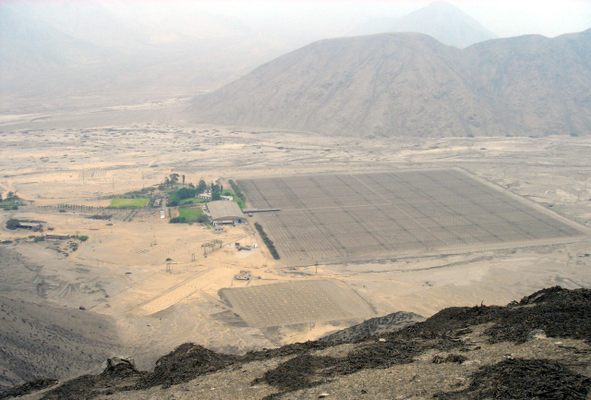About
The primary instrument at the Jicamarca Radio Observatory is an incoherent scatter radar, a type of atmospheric probe of which there are only a handful in the world. While your ordinary radar system or radio telescope has an appearance similar to a gigantic TV dish, the instrument at Jicamarca takes the form of 18,432 dipole antennae spread over nearly 85,000 square meters of Peruvian desert. Located about 25 kilometers outside the capital city of Lima, the observatory was built from 1960-61 for the purpose of studying the furthest reaches of our planet's atmosphere.
The underlying concept of radar (radio detection and ranging) is simple: a radio wave is transmitted in the direction of a target and the reflection of that wave is analyzed. From the time delay between transmission and reception of the signal, the distance to the object can be determined. And from other characteristics of the reflected signal, various properties of the target itself may also be investigated. At Jicamarca, the target is the ionosphere, the uppermost part of the atmosphere located from about 100 kilometers above the Earth's surface and beyond.
Usually radar targets are discrete, solid objects such as planes or satellites. However, the ionosphere is a rather sparse layer of gas, where the density can drop to a mere 10,000 particles per cubic centimeter. For this reason, the radar at Jicamarca requires both an enormous power output and the utmost sensitivity to record the atmosphere's weak reflections. While the power of the transmitted signal measures around two million watts (more power than 33,000 sixty watt light bulbs), the strength of the return signal is typically measured in only picowatts. To get an idea, a picowatt is one millionth of a microwatt, which is in turn one millionth of a watt. Put roughly, if the transmitted signal represented an entire beach, the returns would amount to only a few meager grains of sand.
The reason why the atmospheric reflections are so weak has to do with the name of the instrument, "incoherent scatter radar." Through a process known as Thomson scattering, the transmitted radio waves cause electrons in the ionosphere to oscillate and subsequently emit small amounts of energy of their own. This energy constitutes the return signal and the "incoherent" in the instrument's name comes from the fact that scientists are observing the collective emissions from a group of electrons rather than the energy from one single particle. So, while an incoherent scatter radar might sound like a machine used to produce a random mess of stuff, it is in fact a precise scientific instrument! The Jicamarca observatory is operated by the Geophysical Institute of Peru. As one of the most sensitive atmospheric radars in the world, the Jicamarca instrument can probe the atmosphere up to altitudes of 5000 kilometers and higher.
Related Tags
Know Before You Go
The observatory is about half an hour drive inland (east) from Lima and 10 kilometers from the Central Highway.
Peru: Machu Picchu & the Last Incan Bridges
Discover Inca Wonders.
Book NowCommunity Contributors
Added By
Published
January 10, 2010






















